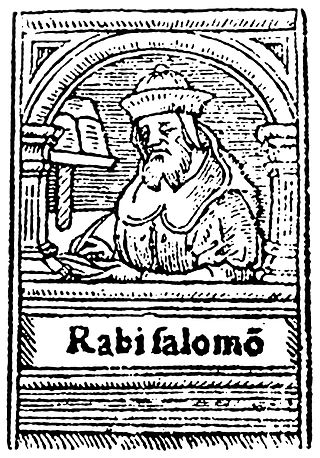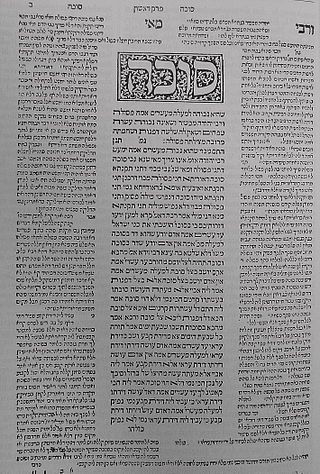Related Research Articles

Shlomo Yitzchaki, commonly known by the acronym Rashi, was a French rabbi who authored comprehensive commentaries on the Talmud and Hebrew Bible.

The Talmud is, after the Hebrew Bible, the central text of Rabbinic Judaism and the primary source of Jewish religious law (halakha) and Jewish theology. Until the advent of modernity, in nearly all Jewish communities, the Talmud was the centerpiece of Jewish cultural life and was foundational to "all Jewish thought and aspirations", serving also as "the guide for the daily life" of Jews.

Rabbinic literature, in its broadest sense, is the entire spectrum of works authored by rabbis throughout Jewish history. The term typically refers to literature from the Talmudic era, as opposed to medieval and modern rabbinic writings. It aligns with the Hebrew term Sifrut Chazal, which translates to “literature [of our] sages” and generally pertains only to the sages (Chazal) from the Talmudic period. This more specific sense of "Rabbinic literature"—referring to the Talmud, Midrashim, and related writings, but hardly ever to later texts—is how the term is generally intended when used in contemporary academic writing. The terms mefareshim and parshanim almost always refer to later, post-Talmudic writers of rabbinic glosses on Biblical and Talmudic texts.

The Masoretic Text is the authoritative Hebrew and Aramaic text of the 24 books of the Hebrew Bible (Tanakh) in Rabbinic Judaism. The Masoretic Text defines the Jewish canon and its precise letter-text, with its vocalization and accentuation known as the mas'sora. Referring to the Masoretic Text, masorah specifically means the diacritic markings of the text of the Jewish scriptures and the concise marginal notes in manuscripts of the Tanakh which note textual details, usually about the precise spelling of words. It was primarily copied, edited, and distributed by a group of Jews known as the Masoretes between the 7th and 10th centuries of the Common Era (CE). The oldest known complete copy, the Leningrad Codex, dates from the early 11th century CE.

The Jerusalem Talmud or Palestinian Talmud, also known as the Talmud of the Land of Israel, is a collection of rabbinic notes on the second-century Jewish oral tradition known as the Mishnah. Naming this version of the Talmud after Palestine or the Land of Israel—rather than Jerusalem—is considered more accurate, as the text originated mainly from Galilee in Byzantine Palaestina Secunda rather than from Jerusalem, where no Jews lived at the time.

Daniel Bomberg was one of the most important early printers of Hebrew books. A Christian Hebraist who employed rabbis, scholars and apostates in his Venice publishing house, Bomberg printed the first Mikraot Gdolot and the first complete Babylonian and Jerusalem Talmuds, based on the layout pioneered by the Soncino family printers, with the commentaries of Rashi, and of the Tosfot in the margins. The editions set standards that are still in use today, in particular the pagination of the Babylonian Talmud. His publishing house printed about 200 Hebrew books, including Siddurim, responsa, codes of law, works of philosophy and ethics and commentaries. He was the first Hebrew printer in Venice and the first non-Jewish printer of Hebrew books.

David Kimhi (1160–1235), also known by the Hebrew acronym as the RaDaK (רַדָּ״ק), was a medieval rabbi, biblical commentator, philosopher, and grammarian.
Peshat is one of the two classic methods of Jewish biblical exegesis, the other being Derash. While Peshat is commonly defined as referring to the surface or literal (direct) meaning of a text, or "the plain literal meaning of the verse, the meaning which its author intended to convey", numerous scholars and rabbis have debated this for centuries, giving Peshat many uses and definitions.
Soncino Press is a Jewish publishing company based in the United Kingdom that has published a variety of books of Jewish interest, most notably English translations and commentaries to the Talmud and Hebrew Bible. The Soncino Hebrew Bible and Talmud translations and commentaries were widely used in both Orthodox and Conservative synagogues until the advent of other translations beginning in the 1990s.
Jewish commentaries on the Bible are biblical commentaries of the Hebrew Bible from a Jewish perspective. Translations into Aramaic and English, and some universally accepted Jewish commentaries with notes on their method of approach and also some modern translations into English with notes are listed.
Felix Pratensis was a Sephardic Jewish scholar who embraced Roman Catholicism. He is known for his collaboration with the Flemish printer Daniel Bomberg on the first printed Hebrew Biblia Rabbinica (Veneta) of 1517/8.
Jewish printers were quick to take advantages of the printing press in publishing the Hebrew Bible. While for synagogue services written scrolls were used, the printing press was very soon called into service to provide copies of the Hebrew Bible for private use. All the editions published before the Complutensian Polyglot were edited by Jews; but afterwards, and because of the increased interest excited in the Bible by the Reformation, the work was taken up by Christian scholars and printers; and the editions published by Jews after this time were largely influenced by these Christian publications. It is not possible in the present article to enumerate all the editions, whole or partial, of the Hebrew text. This account is devoted mainly to the incunabula.
The Hebrew incunabula are a group of Hebrew books, papmphlets or broadside printed before the year 1501.

Sifrei Kodesh, commonly referred to as sefarim, or in its singular form, sefer, are books of Jewish religious literature and are viewed by religious Jews as sacred. These are generally works of Torah literature, i.e. Tanakh and all works that expound on it, including the Mishnah, Midrash, Talmud, and all works of Musar, Hasidism, Kabbalah, or machshavah. Historically, sifrei kodesh were generally written in Hebrew with some in Judeo-Aramaic or Arabic, although in recent years, thousands of titles in other languages, most notably English, were published. An alternative spelling for 'sefarim' is seforim.
Jack Valmadonna Lunzer (1924–2016) was an industrial diamond merchant and the custodian of the Valmadonna Trust Library.
Jehiel ben Jekuthiel Anav, also referred to as Jehiel ben Jekuthiel ben Benjamin HaRofe, who lived in Rome during the thirteenth and fourteenth centuries, was a famous scholar, poet, paytan and copyist.

Rabbi Judah Gedalia was a Portuguese Sephardi Jew who was a rabbinic scholar and a printer. Born in Lisbon in the 15th century, he moved to Salonica after the expulsion. Gedalia died about 1526 in Salonica. His printing press was continued by his children and produced some thirty works.
Solomon Ma'tuk, or Sulayman ben David Ma'tuk or Matuq was a communal leader, astronomer and Jewish devotional poet of Baghdad, whose piyyutim are still incorporated in Iraqi Jewish liturgy.
The Bologna Guild of Silk Weavers were a guild of Jewish silk weavers in Bologna during the 1530s and 1540s.
References
- 1 2 3 4 "National Library gets finest collection of Hebrew prints and manuscripts | World Israel News". World Israel News. 2017-01-24. Retrieved 2017-02-02.
- 1 2 3 4 5 6 7 8 9 10 11 12 13 14 "A Lifetime’s Collection of Texts in Hebrew, at Sotheby’s", Edward Rothstein, New York Times , February 11, 2009
- 1 2 3 4 5 6 7 "Rare Trove of Hebrew Books Displayed in NYC", Beliefnet News, February 10, 2009
- 1 2 "Tablet Magazine" . Retrieved 23 December 2015.
- ↑ "'Manifesto,' From 1848, Is Sold for $39,811", New York Times , May 30, 1986
- ↑ Cohen, Debra Nussbaum. "Receiving the Original Text Messages". The Jewish Daily Forward. May 13, 2009 (issue of May 22, 2009)
- ↑ Valmadonna goes back on the market, by Robyn Rosen, 11 May 2011, The Jewish Chronicle , accessed 21 March 2012.
- ↑ Fine Books Magazine, accessed 5 January 2016